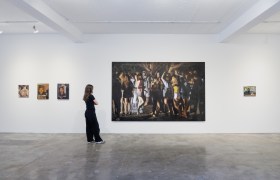Last month, an Australian colleague alerted us to Madelon Galland’s STUMP Project, which had caught the attention of Australian Broadcasting Corporation’s arts blog Articulate, and from there it was picked up by superblog Boing Boing, then art.blogging.la in Los Angeles, and finally the Wooster Collective in NYC, where the project originated in 1999.
We contacted her by e-mail at her home in France, to see how the project was progressing, and to ask what else she had been working on in the meantime, and she graciously responded with a short essay that seemed a perfect candidate for our first Artist’s Voice profile.
By way of background, here’s what Galland wrote about the STUMP Project in “How to Upholster a Tree Stump” at the online do-it-yourself resource site, SuperNaturale.
The STUMP project began in 1999 on the sidewalks of New York City — the sidewalk plots where there are tree stumps are generally neglected spaces left to collect debris. The tree stumps reminded me of the childhood story, The Giving Tree by Shel Silverstein, in which a tree has given of herself to the point of being diminished to a stump, but selflessly perks herself up to give to the last, by providing a seat for the beloved boy who is now an aged man. To upholster the sidewalk stump was a way to honor that which had been diminished, and bring it back into relationship with the neighborhood. I am interested by what happens in a public space when I demonstrate care for something which is not mine. I am still motivated to respond to the world in this way and am frequently nursing sick street dogs. To kneel down to the disparaged has been a tremendous opportunity for opening the heart. And it addresses the displaced and reductive state of our relationship to nature in an urban environment, or any so called civilized society. Wherever upholstering a tree stump is sited, it speaks to our relationship with what has been cast off and it is an activation and sublimation of dejected forms and neglected spaces.
Now she describes how things have developed since then.
The STUMP project continued until I left the city to travel in India in 2003. I have been living overseas for ever since (with only visits to USA and to do some printmaking residencies).
At present the only upholstered stump that I know is still intact on-site is in San Rafael, California. I made it this summer and it is on the dividing line between two properties with a fence running across it.
During the project’s inception, I upholstered stumps in San Francisco, New York, Brooklyn, and Rome, Italy. Later I was invited to come make upholstered stumps in public art exhibitions in New Jersey and Memphis, Tennessee, and more recently in Portland, Maine.
There really aren’t maps [or where upholstered stumps are located] because the work was often quite ephemeral, and while some pieces remained in good shape, many were subject to graffiti or vandalism and the inevitable planting of a new tree by the city.
Part of the enjoyment was the mystery of beholding such a site during an average pedestrian stroll, and to entertain the questions that arose. There were no plaques or signposts or explanations given and the audiences were not necessarily art connoisseurs.
This was the joy for me — to watch an old man step on the little red vinyl stump…

…to hear the imaginings of passersby as to what the function was, and their assumptions of my role. I often wore green trousers to look somewhat official, as it was radical for me to stand still in Manhattan — to step out of the current of movement and into the eddy of the stationary sidewalk trees and be seen.
At present I have just moved to France where I will have a working studio again and I am living in a forest of inspiration in the mountains of Cevenne National Park.
However context is everything: the inspiration and motivation to upholster the tree stumps in New York was specifically a response to the urban context and the ambiguity for the responsibility of these dejected spaces in sidewalk plots. There were also some uprooted stumps I was able to obtain and upholster more lavishly for interior installation; a few of these are still in storage or in possession of collectors in New York and New Jersey.
On another note, besides invitations to make site specific works for exhibition, there was no other authorizations. The pieces I made in the cities seemed to last longer where they we NOT within Parks Department jurisdiction. Considering the anonymous or renegade way in which I was working, I was surprised that I got a call from the New York Times for an interview, which led to an article in the London Times and also a segment on CNN, a short droll documentary by Jeannie Moos, all in 2000.
It feels good to know that due to the article in Super Naturale’s website and the expansion of web links, this project is reaching new audiences and garnering interest again. The “How To” piece is also an invitation for the project to continue and proliferate and not be dependent on my craftsmanship or whereabouts. I have yet to receive any photos of completed projects, but I will welcome them.
All the best,
Madelon Galland




